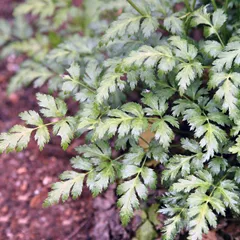Use of Ban Lan Gen (woad roots) in TCM
Please note that you should never self-prescribe TCM ingredients. A TCM ingredient is almost never eaten on its own but as part of a formula containing several ingredients that act together. Please consult a professional TCM practitioner, they will be best able to guide you.
Preparation: Remove impurities, wash, soak in water, cut in thick slices and dry.
Dosage: 10 - 30 grams
Main actions according to TCM*: Expels Heat and Fire toxicity. Cools the Blood. Dispels Damp-Heat in the Lower Burner.
Primary conditions or symptoms for which Ban Lan Gen may be prescribed by TCM doctors*: Mumps Pharyngitis Laryngitis Fever Erysipelas Carbuncles
Contraindications*: This herb should not be used by those who are without true Fire toxicity.
Common TCM formulas in which Ban Lan Gen is used*
Pu Ji Xiao Du Yin
Source date: 1202 AD
Number of ingredients: 14 herbs
Formula key actions: Clears Toxic-Heat. Clears Wind-Heat .
Conditions targeted*: FurunclesCarbuncles and others
Ban Lan Gen is a deputy ingredient in Pu Ji Xiao Du Yin. This means it helps the king ingredient(s) treat the main pattern or it serves to treat a coexisting pattern.
In Pu Ji Xiao Du Yin, Ban Lan Gen clear Heat from the throat and relieve the Toxic-Fire there.
Key TCM concepts behind Ban Lan Gen's properties
In Traditional Chinese Medicine (TCM), Ban Lan Gen belongs to the 'Herbs that cool the Blood' category. Herbs in this category are used to clear inflammatory and infectious conditions, referred to as 'Internal Heat' in TCM. This is why most of the herbs in this category will have both antibacterial and antiviral properties. In TCM one has too much 'Internal Heat' in their body as a result of a deficiency of 'Yin' (which is Cold in nature, see our explanation on Yin and Yang) or, more commonly, an Excess of Yang (Hot in nature). Herbs that cool the Blood treat the latter and as such tend to be Cold or Neutral in nature.
As suggested by its category Ban Lan Gen is Cold in nature. This means that Ban Lan Gen typically helps people who have too much 'Heat' in their body. Balance between Yin and Yang is a key health concept in TCM. Those who have too much Heat in their body are said to either have a Yang Excess (because Yang is Hot in nature) or a Yin deficiency (Yin is Cold in Nature). Depending on your condition Ban Lan Gen can help restore a harmonious balance between Yin and Yang.
Ban Lan Gen also tastes Bitter. The so-called 'Five Phases' theory in Chinese Medicine states that the taste of TCM ingredients is a key determinant of their action in the body. Bitter ingredients like Ban Lan Gen tends to have a cleansing action on the body by clearing Heat, drying Dampness and promoting elimination via urination or bowel movements.
The tastes of ingredients in TCM also determine what Organs and Meridians they target. As such Ban Lan Gen is thought to target the Stomach and the Liver. In TCM the Stomach is responsible for receiving and ripening ingested food and fluids. It is also tasked with descending the digested elements downwards to the Small Intestine. The Liver on the other hand is often referred as the body's "general" because it is in charge of regulating the movements of Qi and the Body Fluids. It also takes a leading role in balancing our emotions.
Research on Ban Lan Gen
Woad root eyedrops have an excellent efficacy and safety on the acute bacterial conjunctivitis.1
Huanglan Granule (containing woad root) has obvious inhibitory effect on the rubella virus.2
Sources:
1. Qi CX, Wu XM, Wang XL. (2007 ). Clinical research of isatis root eyedrops on the acute bacterial conjunctivitis. Zhong Yao Cai. , 30(1):120-2.
2. He Y, Hao XP, Yang D. (2008). Clinical and experimental study on effects of huanglan granule in inhibiting rubella virus. Zhongguo Zhong Xi Yi Jie He Za Zhi. , 28(4):322-5.





